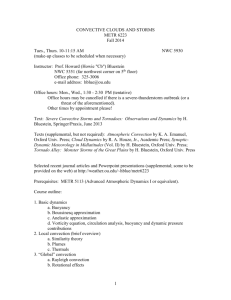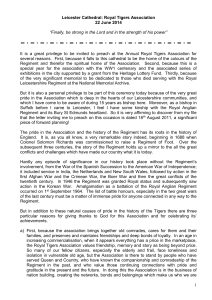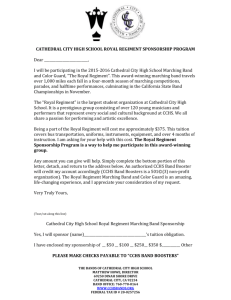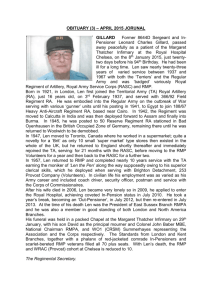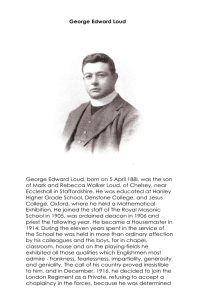Southwood Killed Dieppe - The Royal Regiment of Canada
advertisement
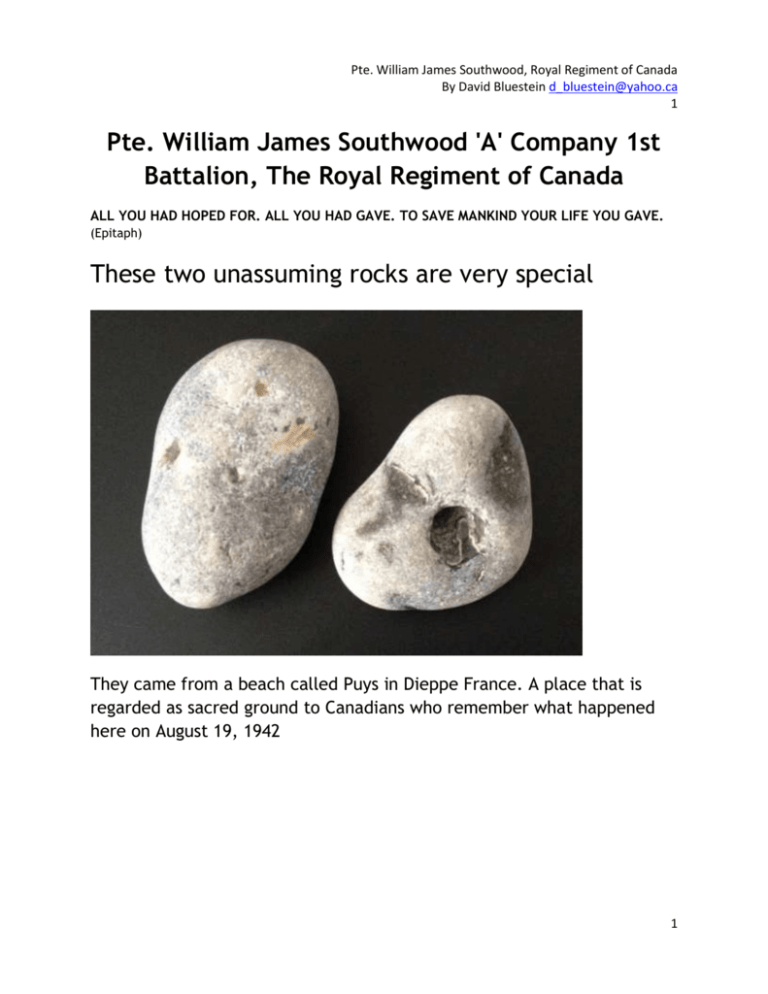
Pte. William James Southwood, Royal Regiment of Canada By David Bluestein d_bluestein@yahoo.ca 1 Pte. William James Southwood 'A' Company 1st Battalion, The Royal Regiment of Canada ALL YOU HAD HOPED FOR. ALL YOU HAD GAVE. TO SAVE MANKIND YOUR LIFE YOU GAVE. (Epitaph) These two unassuming rocks are very special They came from a beach called Puys in Dieppe France. A place that is regarded as sacred ground to Canadians who remember what happened here on August 19, 1942 1 Pte. William James Southwood, Royal Regiment of Canada By David Bluestein d_bluestein@yahoo.ca 2 THIS IS PUYS ON THAT HORRIBLE DAY The terrible image of tangled heaps of dead men of Canada's Royal Regiment against the sea wall at Puys. ONE OF THOSE MEN WAS LIKELY THIS MAN. 2 Pte. William James Southwood, Royal Regiment of Canada By David Bluestein d_bluestein@yahoo.ca 3 PURE SLAUGHTER - BLUE BEACH WEDNESDAY AUGUST 19, 1942 As the assault craft scraped bottom several yards offshore, the bow doors opened to allow the soldiers to storm ashore. The opening of those doors was the signal for an intense enemy cross-fire from the machine-guns on the cliff. The men of the Royals gallantly tried to reach the beach, but many of them were cut down before they could cover the few yards separating them from the shingle. Dead and wounded piled up in the doorways of the landing craft or sank and struggled in the shallow water. The sea-wall was only 40 yards away, but not more than 15 men of the first wave reached it. The enemy machine gun and mortar fire ruthlessly tore into the ranks of the struggling Royals. The intensity of the storm of fire power against them was impossible to escape – these fine young Canadian soldiers were literally shredded to pieces as they came onto the beach.(Battle Royal, Major D.J. Godspeed, The Royal Regiment of Canada, 1962.) Canadian's storming the beach at Juno on D-Day; I can’t help but imagine that it may have looked 3 Pte. William James Southwood, Royal Regiment of Canada By David Bluestein d_bluestein@yahoo.ca 4 similar on August 19, 1942 The Royals fought back as best they could. Many men continued to fire their weapons long after they had been hit, and innumerable gallant attempts were made to rescue wounded comrades. All to no avail, for the pitiful handful of survivors by the sea wall could do little. Within a matter of minutes, Puys Beach was a bloody shambles. (Battle Royal, Major D.J. Godspeed, The Royal Regiment of Canada, 1962.) Enemy fire hit the landing craft from the moment they came into range. As the small boats grounded on the beach and dropped their ramps, they were struck by a torrent of machine gun fire that devastated the Canadian troops inside. Without leaving the small boats countless men were mown down where they stood. Men cowered to the open sides as though they were sheltering from the rain, but there was little cover to be had in the open-fronted craft. The more determined od the Royals braved the whirlwind of bullets and ran pell-mell for the sea wall, hugging its towering stone sides to escape the German fusillade. Pillboxes on the cliffs to the left looked down and along almost the entire line of the wall allowing the German troops inside to pick off individuals one by one. Within just seconds order was completely lost. The assault wave of the battalion had 4 Pte. William James Southwood, Royal Regiment of Canada By David Bluestein d_bluestein@yahoo.ca 5 become a disorganized mass of individuals each seeking shelter from the hail of fire. Every time some effort was made to surmount the wall and blow the wire, the men attempting the feat were destroyed by machine guns. For 20 minutes officers tried to regroup the men and find a way off the beach. Then a second wave arrived. It too received the full weight of the enemy fire from close range, decimating the men in the landing craft and those that braved the open beach. The whole attack was failing badly. Great acts of heroism took place on Blue Beach that morning. A breach was made in the wire and Lt. Col.Cato and a few men got off the beach into houses on the right, but their progress inland was slow and costly. This small party made it to the top of the cliff but no others were able to join it, the gap in the wire having effectively closed by interdictory fire. (Dieppe 1942 Ken Ford Osprey Publishing) AND THEN IT WAS OVER - HEARTBREAKING 5 Pte. William James Southwood, Royal Regiment of Canada By David Bluestein d_bluestein@yahoo.ca 6 No image of August 19, 1942 more strongly impacted me. This German photograph showing some of the dead of the Royal Regiment heaped onto a wagon sends a chill down my spine every time I see it. 6 Pte. William James Southwood, Royal Regiment of Canada By David Bluestein d_bluestein@yahoo.ca 7 By 8:30am resistance on Puys had stopped, the slaughter was finished. The Royals has suffered 94% casualties. One of the dead was this man, WilliamJames Southwood of Toronto. And this is all that remains as a testament to his life The Canadian Memorial Cross with service medals and the Indian General Service medal awarded to 7 Pte. William James Southwood, Royal Regiment of Canada By David Bluestein d_bluestein@yahoo.ca 8 his grandfather for service in Burma in 1892. THIS IS HIS STORY William James Southwood was born at 129 Lindsay Avenue Toronto Ontario on April 13, 1913. He was the son of James and Alice Elizabeth Southwood. He was the youngest son, with three older sisters – Florence Violet (1902), Lillian Daisy (1904), Alice Rose (1906). Lindsay Avenue pictured from Dufferin St., catching Mrs. Nottingham buying bananas from a vender, around the time the Southwood family lived there. Incredible to think that young William walked this very street. Toronto Public Library The family moved to 76 Athabaska Avenue in Newtonbrook Ontario, which is a north Toronto address. William attended Western Technical High School on Evelyn Cres., in Toronto for a period of four years. Their war memorial includes his name amongst others of the school killed in the war. He worked as a `Shipper` before enlisting into the army. His father James died just before the war on January 6, 1939. 8 Pte. William James Southwood, Royal Regiment of Canada By David Bluestein d_bluestein@yahoo.ca 9 Western Technical School in an old hand painted postcard. The school is still in use today. WAR 1939 William joined the Royal Regiment of Canada at Toronto almost immediately upon the declaration of war on September 7, 1939. The Regiment was taking recruits inside the government building on the grounds of the Canadian National Exhibition. He likely had a strong sense of loyalty to this county, and a long family tradition of service; His grandfather was a soldier, who served his Queen in the British Army on campaign in Burma in 1892. It is surmised (but not confirmed at this time) that his father was likely also a soldier in the Great War. William Southwood was shown as being 5 foot 6 inches, and weighing 115 pounds with a dark complexion, brown eyes, and hair and listed his mother Alice Southwood as his next of kin, 76 Athabaska Avenue. He was assigned Regiment number B66568, and attached to 'A' Company The Royal Regiment of Canada. 9 Pte. William James Southwood, Royal Regiment of Canada By David Bluestein d_bluestein@yahoo.ca 10 ICELAND By the spring of 1940, the Germans had taken Norway and the British expected that their next move would be Iceland. This would be a disastrous for Allied ships crossing the ocean, as the Germans would be in command of the North Altlantic. The Royal Regiment was the most available regiment, and so they were chosen to bolster the British forces that were already there. They would be part of ‘Z’ Force and wear the polar bear on their sleeve. (Destined to Survive, A Dieppe Veterans Story By Jack A. Poolton with Jayne Poolton-Turvey) William Southwood and the Royals embarked at the port of Halifax for Iceland on June 10, 1940. They disembarked at Reykjavik Iceland on June 16. Pte. Jack Poolton of the Royal Regiment, a member of D Company remembered the following, as detailed in his book 'Destined to Survive, A Dieppe Veterans Story': 10 Pte. William James Southwood, Royal Regiment of Canada By David Bluestein d_bluestein@yahoo.ca 11 Pte. Jack Poolton RRC ‘ We arrived at Reykjavik, Iceland at midnight on June 16, 1940, with the sun still shining. We were immediately unloaded off the ship, as a German submarine had been reported in the area. Before leaving ship, we were told that the majority of the people were hostile and that it was possible that some of them might spit in our faces. If this happened, we were told not to retaliate, as we were visitors, not invaders’ (Destined to Survive, A Dieppe Veterans Story By Jack A. Poolton with Jayne Poolton-Turvey) ENGLAND There was little sadness when the Royals were ordered to England from their post in Iceland. They embarked on board the Empress of Australia on October 28, and arrived in England on November 3, 1940. ‘Prior to the Royals leaving Iceland for Scotland, we were taken out in to a secluded valley and notified by the colonel that we would be leaving for England to join the second Division. This was the best news I’d heard in six months. A few days later I was sitting with other Royals in Reykjavik. Lord Haw Haw (William Joyce the traitor) made a radio announcement from Germany in English shortly and that the Royal Regiment was leaving for England shortly and their ship would be sunk on the way there.’ ‘We finally arrived and sailed up the Clyde River to Gourock. After disembarking the Epress of Australia, we boarded trains for Aldershot. I was excited to finally reach the United Kingdom and I could hardly believe how beautiful and peaceful Scotland looked compared to the desolate landscape 11 Pte. William James Southwood, Royal Regiment of Canada By David Bluestein d_bluestein@yahoo.ca 12 of Iceland.’ (Destined to Survive, A Dieppe Veterans Story By Jack A. Poolton with Jayne PooltonTurvey) OPERATION JUBILEE The Royals embarking for Blue Beach - Puys (National Archives) ‘It was beautiful and peaceful night. The channel was as calm as a mill pond. We had mine sweepers ahead as the channel was heavily mined, awere hoping that the Navy would land us at the our proper destination. When the time finally came to transfer to the lanind craft, we went in single file through the dark in silence, holding onto the bayonet scabbard of the man ahead. We were helped across a three-foot space by tow naval ratings into the ALCs. They were then lowered into the sea and we bade farewell to the mother ship and headed for the coast of France.’ (Destined to Survive, A Dieppe Veterans Story By Jack A. Poolton with Jayne Poolton-Turvey) And so these men were moving toward their fate at Dieppe, they sailed unknowingly into the pages of history. My regiment did not go into the main beach, we went into a beach at Puys [France], which is a very narrow beach and it’s shaped like a tunnel, the cliffs go out past the seawall. So that when you go in, you’re taking munitions from the left and the right and the front. When you got on the beach, you’re taking it from the front, left, right and the rear because the guns up on the point of the cliff can fire 12 Pte. William James Southwood, Royal Regiment of Canada By David Bluestein d_bluestein@yahoo.ca 13 right down on the seawall. So we were in the total enfilade of fire. My regiment put 500 men on the beach, 300 men were killed in less than 20 minutes. And how I survived, I’ll never know. All I know is that I did. And I’ve often thought that the lord must have been standing with us hand on my shoulder, otherwise I wouldn’t be here today. The regiment was taking casualties right, left and centre and finally, one of the officers, he was the senior officer on the beach, he was lieutenant, everybody else was dead. And he said, “We’ve taken too many casualties, we don’t want to take anymore, has anybody got a white towel or a white handkerchief or a piece of white paper that or anything at all to put on a bayonet and put it up.” So one of the men got a white towel out of his pack, which he shouldn’t have had with him in the first place, and he put it on bayonet and he marched down the beach with it. The Germans come down and said, “Don’t worry boys, you’re alright, you won’t be hurt. You won’t be hurt. For you, the war is over.” And we thought, I wonder if it really is? (Mr. Ron Beal of The Royal Regiment, from a transcript - 'The Canadian Memory Project.') 13 Pte. William James Southwood, Royal Regiment of Canada By David Bluestein d_bluestein@yahoo.ca 14 A clipping from the Toronto Star after the raid on Dieppe shows, amongst others William James Southwood. 14 Pte. William James Southwood, Royal Regiment of Canada By David Bluestein d_bluestein@yahoo.ca 15 At home first reports celebrated the raid as a great success – but the true story emerged as extensive casualty lists were being published in local newspapers. Among the scores of dead, wounded and missing being listed was Pte. William James Southwood. The family home of 76 Athabaska received a dreaded telegram from the war office dated August 25, 1942. It was not until January 1943, that the Department of National Defense confirmed that their son had been killed: ‘This is to certify that according to information received at the Department of National Defense from the overseas authorities, No. B.66568, Private William James Southwood, of the Royal Regiment of Canada, Canadian Army, was killed in action on the 19th August 1942.’ His remains were recovered from the beach, likely one of those of 'A' Company who's bodies were heaped against the sea wall. Today he lies buried in row J, grave 34 Dieppe Canadian War Cemetery, Seine-Maritime, France. 15 Pte. William James Southwood, Royal Regiment of Canada By David Bluestein d_bluestein@yahoo.ca 16 ALL YOU HAD HOPED FOR. ALL YOU HAD GAVE. TO SAVE MANKIND YOUR LIFE YOU GAVE (Epitaph) If anyone would like more information on William James Southwood please contact me. David Bluestein d_bluestein@yahoo.ca 16

